The Villa That Nearly Killed Us
Our misadventures building an investment property on a tropical island in Thailand
Today I’m sharing the drama that has been our villa build in Koh Phangan, Thailand, for the past 2 years, and I’m not holding back. I’ve included plenty of photos, videos, and even TikToks so you can really get a feel for the whole insane process. If you like this post and want to read more of them, subscribe below so you never miss a post.
It’s almost done.
It’s almost done.
I find myself repeating this daily.
The four-bedroom luxury seaview pool villa we’ve been building for the past two years on Koh Phangan is nearly finished.
Hallelujah.
Because it very nearly killed us.
But to explain the full story, I have to go back to the beginning.
Back to just after my dad died, eight years ago.
He’d been very clear: he hoped I’d invest the portion of his life insurance I’d be getting into property.
This was pre-Covid. Pre-island real estate boom. Before Koh Phangan was transformed — for better or worse.
We’d been living on the island for seven years, slogging our way through our younger entrepreneurial eras. Both running businesses that barely turned a profit.
When we returned from Mexico — grief-stricken, but with cash in our pockets to invest — we took our time finding the perfect plot.
Eventually, we found one around the corner and up the hill from our rental. The view was insane. I still remember thinking it might be the best seaview I’d ever seen. We got a sick deal on it.
But as excited as we were to have land in our name — well, technically in our best Thai friend’s name, but we’re godparents to her son and she’s like family, so it may as well have been — we had no money left. So the land just… sat there. For years.
The Plan That Unlocked It All
A couple of years after we bought the land, we came back to Thailand, fresh from having our baby in Scotland. A friend who Fraser was doing some carpentry work for approached us with an idea.
Subdivide the land, he suggested. Get an excellent architect to design two outstanding villas. Sell off-plan.
A few weeks later, we were sitting across from Bruno — the best architect on the island. And a month or two after that, we had villa designs in hand.
A friend of a friend caught wind of what we were doing and wanted to know more. Next thing we knew, he was signing the contract and wiring us the cash for the first plan.
It was a huge milestone.
Because now, with the money from that first villa, we could fund the build of the second. And that one? We’d sell, and the profit would be ours.
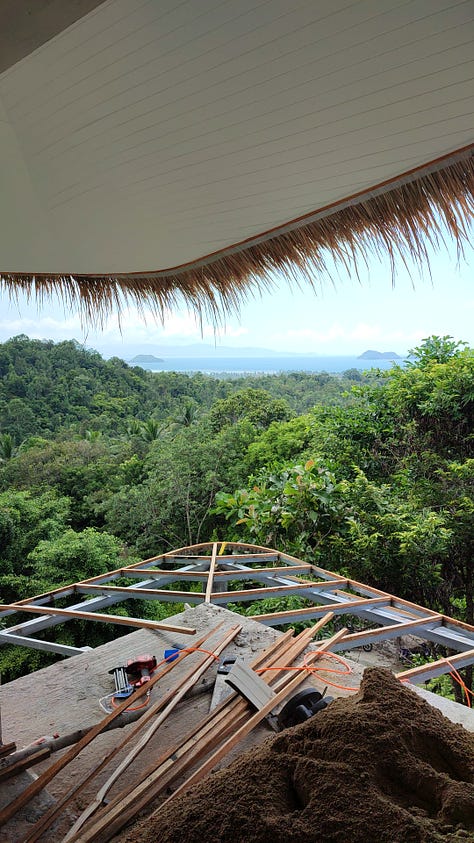


In the end, the same buyer bought both.
Word got out. Fraser was asked to manage the build of a couple more villas. Then came a big project. Then a couple more medium-sized ones.
The fact that we’d been on the island so long, combined with Fraser’s extensive building experience — not to mention his deep knowledge of Thai building laws, which are notoriously complex and next to impossible to follow — meant suddenly everybody wanted his eyes and expertise on their villa.
So he pulled together a team, and Sand & Stone Development was born.
Meanwhile, we set our sights on our next project. Naturally, we wanted to build another villa — this time, bigger, better. We’d take the same design we’d just executed and improve upon it.
Then a close friend got in touch. She and her husband wanted a villa, too.
“Why don’t we just pool our money and build one big one?” we suggested.
And that was that.
We found a new plot through our Thai friend — the same one who helped us with the first. It was priced like a jungle plot, but it sat at the base of a steep hill, and we had a hunch: if we built high enough, there might just be a seaview.
So we sent up a drone.
And we were right.
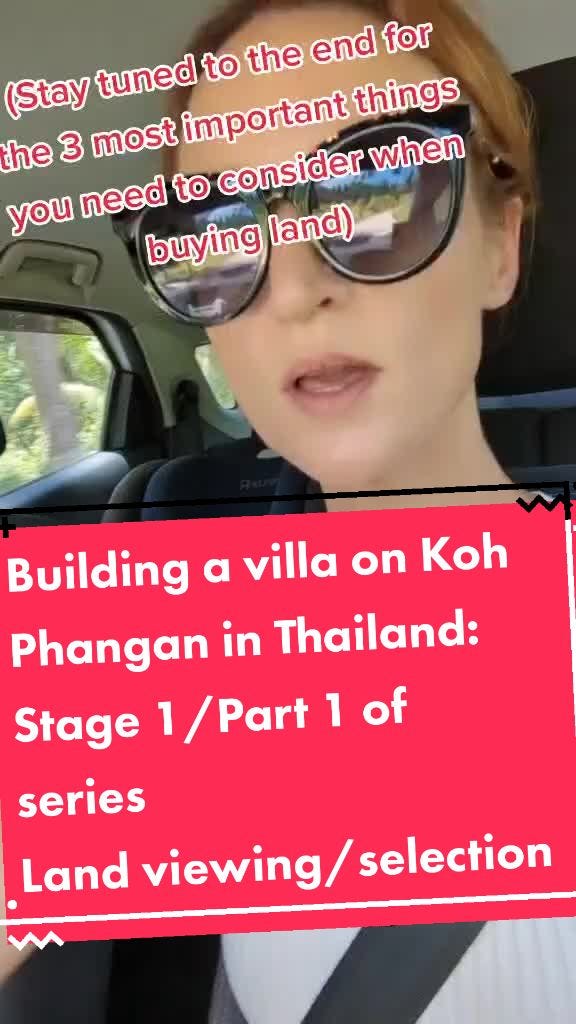
 Tiktok failed to load.
Tiktok failed to load.Enable 3rd party cookies or use another browser
What we saw was magic. A sweeping panoramic view of Chaloklum Bay — one of the most authentic little villages on the island, with a handful of charming cafés and restaurants dotting the beach. There are even rumours of a boardwalk going in. Plus, it was where some of our biggest villa projects were already underway.
The land itself was enormous — about 1,000 square metres. Most villas on the island are built on a fraction of that. It was quiet, lush, and peaceful. A river ran down one side. There were waterfalls.
It felt like a sign.
Fraser revised the original plans with his well-trained eye. We expanded the terrace. Added a sala. Extended a balcony. Got rid of a few ugly pillars. Converted a storage room into a guest room-slash-office.
They were small changes, but smart ones — meaningful upgrades that would add significant value to the final build.
We hired a team we’d known for years. They were trying to break into the luxury space and offered us a solid deal in exchange for the opportunity. Fraser — arguably the most sought-after builder on the island — would be managing them directly. They knew they’d learn a lot. And they knew it’d look good on their portfolio.
Once the building permit came through, construction began.
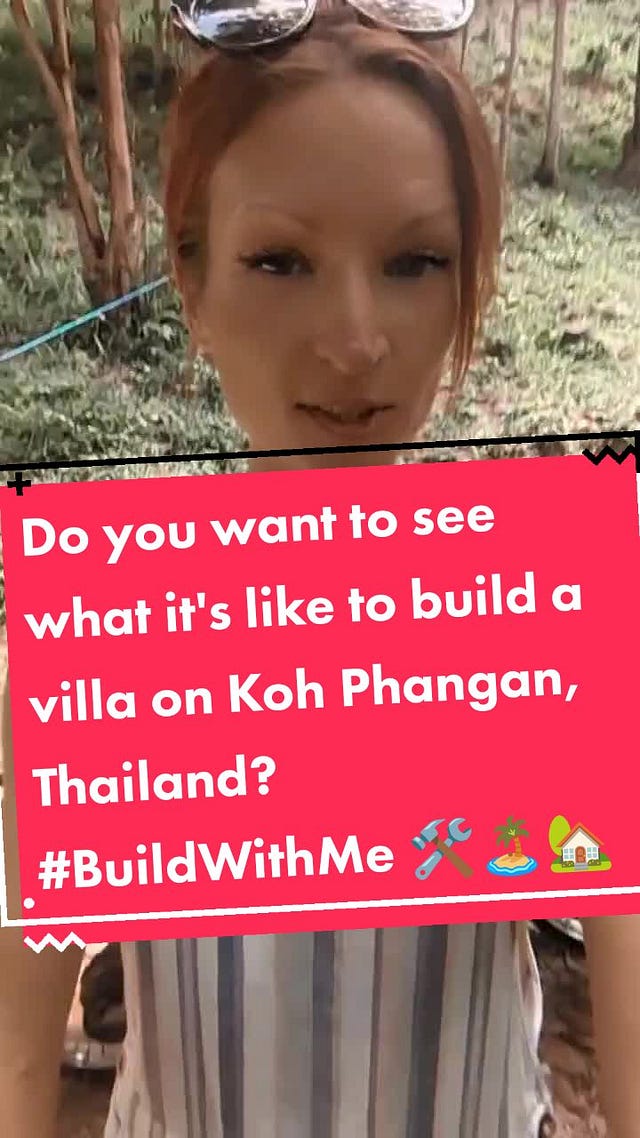
 Tiktok failed to load.
Tiktok failed to load.Enable 3rd party cookies or use another browser
At the same time, we were opening the doors to the new Sand & Stone office. That was no small feat, either. We spent an eye-watering amount on legal fees just to get our team legal — a process that ended up taking far longer than it should have, thanks to the spectacular incompetence of the local legal “professionals.” And on top of that, we poured money into hardware and software for the architecture and 3D visualisation department we were launching.
The Woodrow — as I would end up naming it in a nod to its forested location — would be our first 3D project.
This wouldn't turn out to be a good thing.
Getting nowhere fast
The team was still learning the software, still fumbling through the new systems. Our architect logged over 300 hours building a 3D model of the villa — every corner, every fixture, every flourish mapped out in intricate digital detail. And it looked stunning. (For last year's tech, anyways.)
But then… he told me we couldn’t change anything.
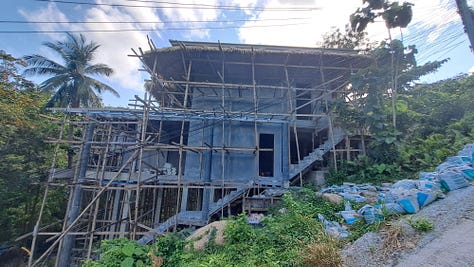
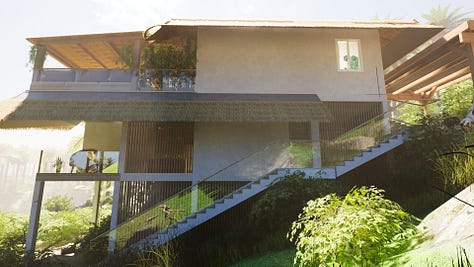
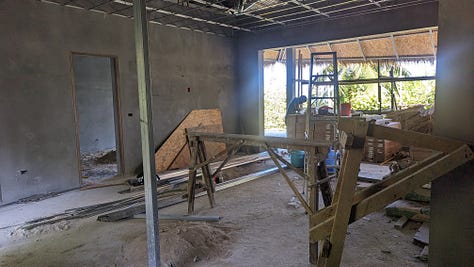
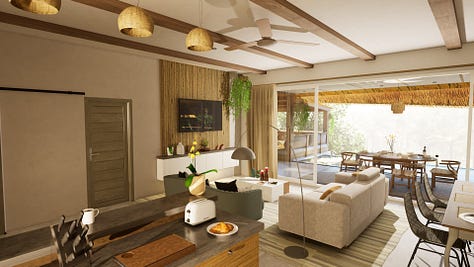
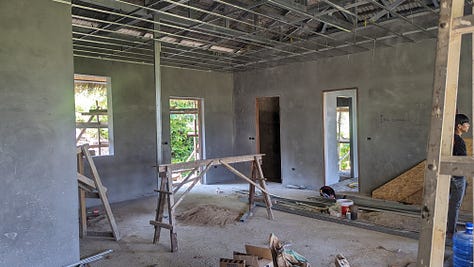
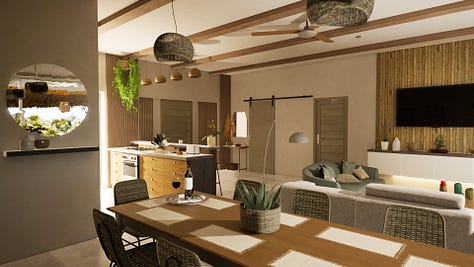
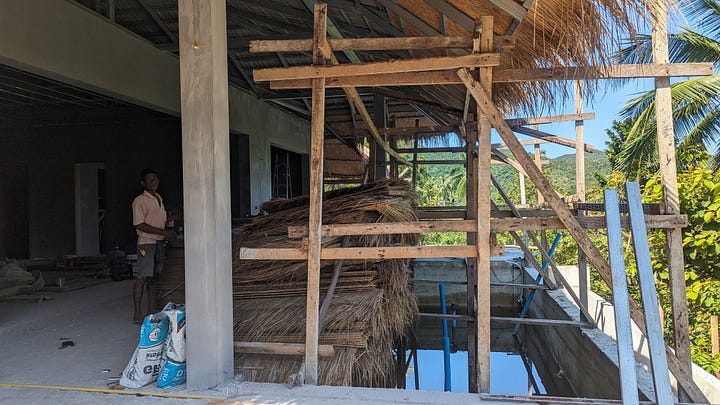
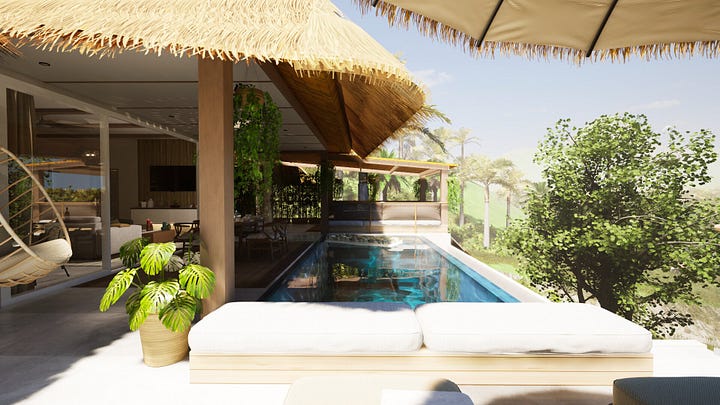
Not that he didn’t want to. That he couldn’t. If he moved a wall, adjusted a window, shifted a line — the whole simulation would collapse.
And it still wasn’t finished.
(He would quickly learn how to refine his process so that this didn't happen, but it wasn't fixable on our model.)
I was in charge of the interiors, you see. And while I was confident in my taste, I was still relatively green. I’d designed the interiors for a couple of bungalows we Airbnbed in town, and they looked great. I’m an artist. A creative. I knew I could do this. But I needed flexibility. I needed to move things around, see how they landed, shuffle things, reimagine them.
That wasn’t possible in the Woodrow’s rigid little digital universe.
I was told I had to stick with the original layout. But I didn’t love it anymore. I knew I could do better. And so, I stopped using it. I let go of the 3D model we’d sunk so many hours and so much company time into.
Which sucked.
And just as we stepped back from the 3D world, things began to fall apart in the real one.
Once the roof was on, the contractors slowed to a crawl.
Apparently, this is pretty standard practice in the trade here. Fraser broke it down for me once: builders here typically get a hefty 40% down payment to build the structure. Once that’s done, the remaining payments — 15% here, 20% there — are smaller, less appealing. So they go off hunting for the next job with a fat deposit. A big reason why people hire construction management companies like ours: to take on that stress of having to chase the builders for those remaining phases.
The number of mornings I drove up to the Woodrow to find not a soul on site — or maybe one or two workers quietly doing God-knows-what — was honestly staggering. Disheartening doesn’t even cover it.
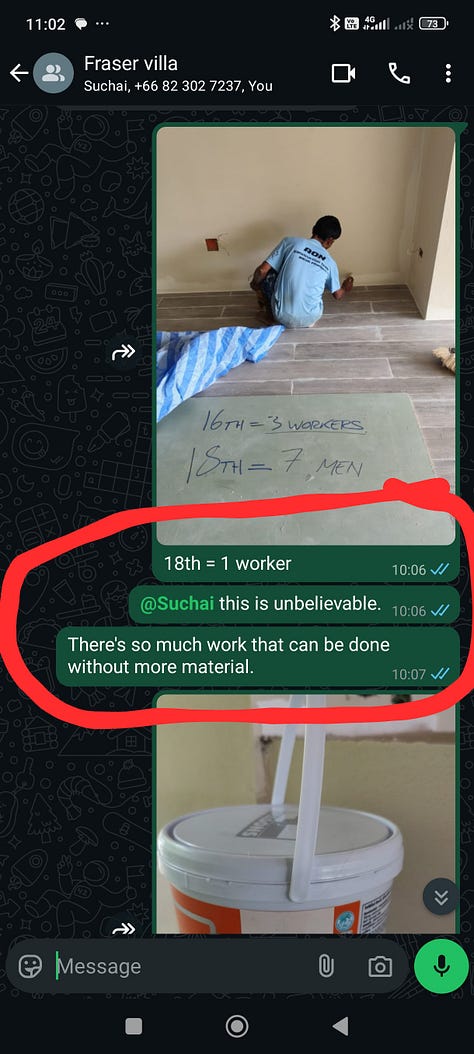

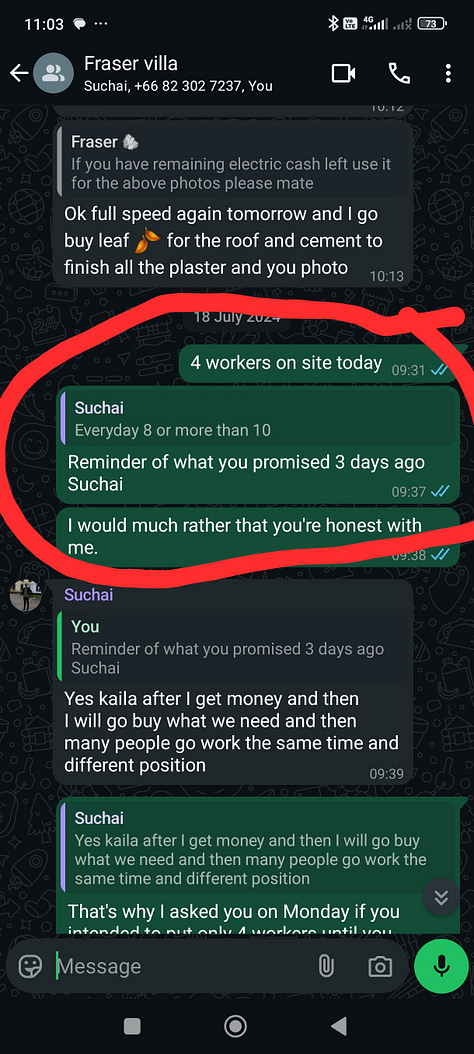
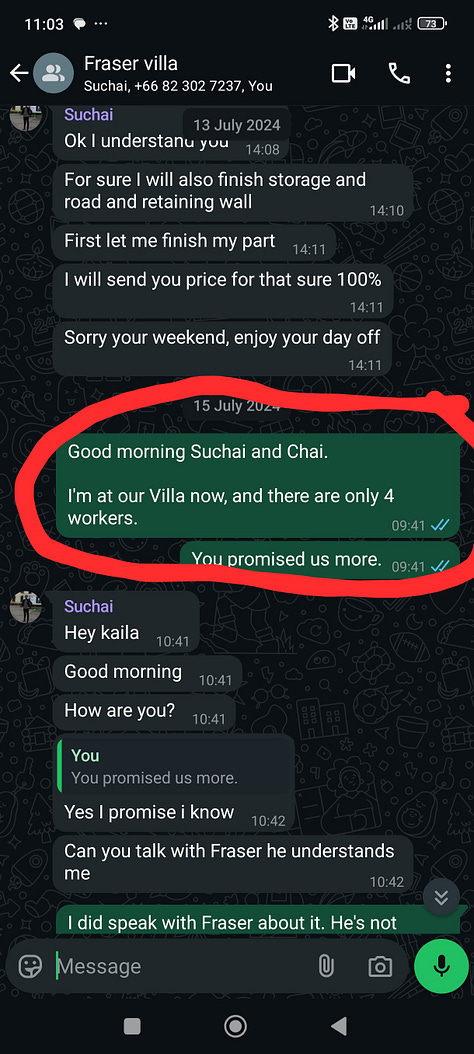
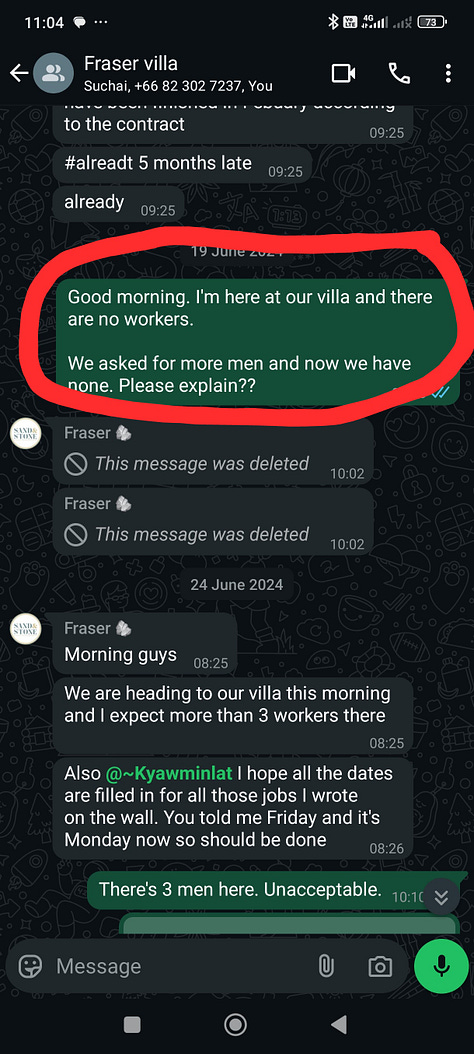
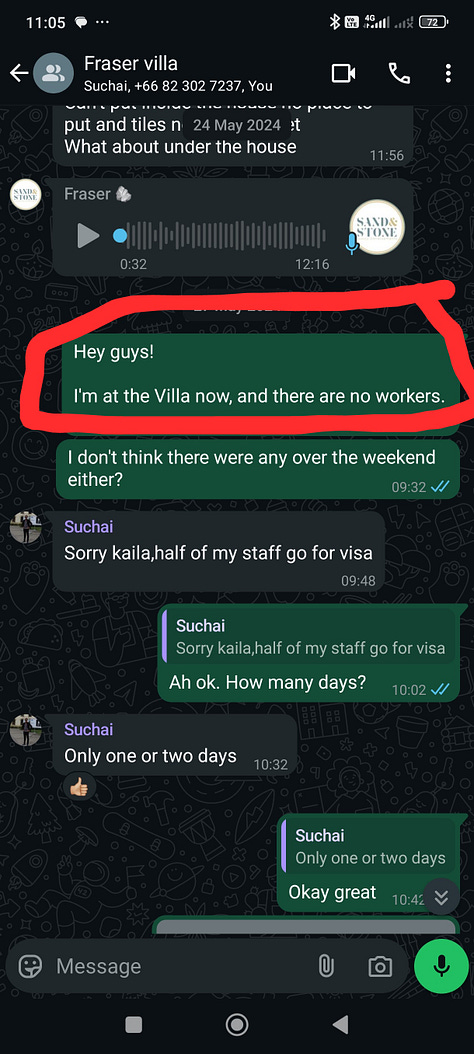
We tried everything. We started soft. Gentle reminders. Deadline nudges. Hints that there was more work waiting if they could just stick to the plan.
Then, the tone shifted. The tension built.
Eventually, it reached boiling point — Fraser and the head of the team nearly came to blows on site.
And that was it.
We fired them.
It’s called ‘character building,’ right?
But there was still so much work left to do.
And first, we had to undo a lot of what had already been done.
That meant bringing in small, specialist teams to fix what the last crew had botched. Pool experts for the pool. Tilers for the tiling. Craftsmen to build and install the doors. The upside? A much higher standard of finish. The downside? A lot more to manage. Because instead of one team lead to chase down when workers didn’t show up or botched something, now we had half a dozen.
Around this time, I started diving deeper into the villa’s interior design. I consulted a few friends who work in interiors and signed up for a couple of courses to learn the basics of layout and flow.
I started by taping everything out — literally. I mapped the rooms with painter’s tape, blocking out where each piece of furniture would go.
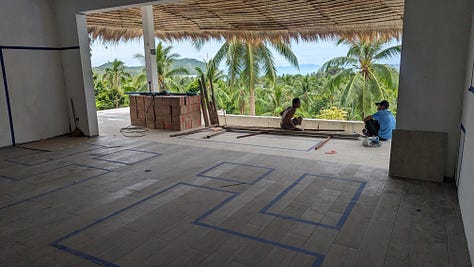
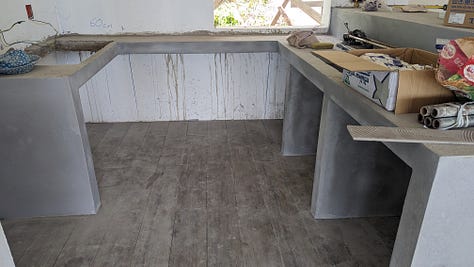
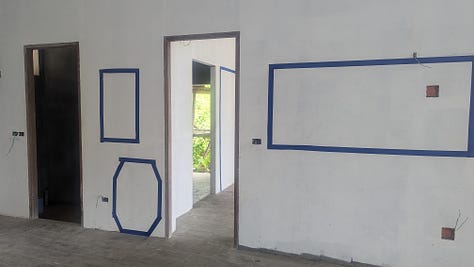
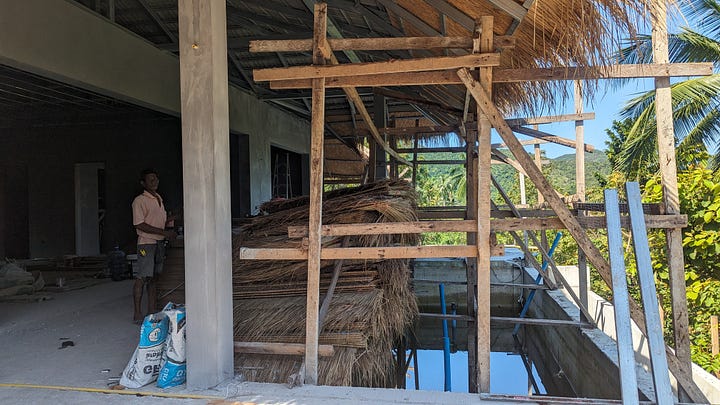
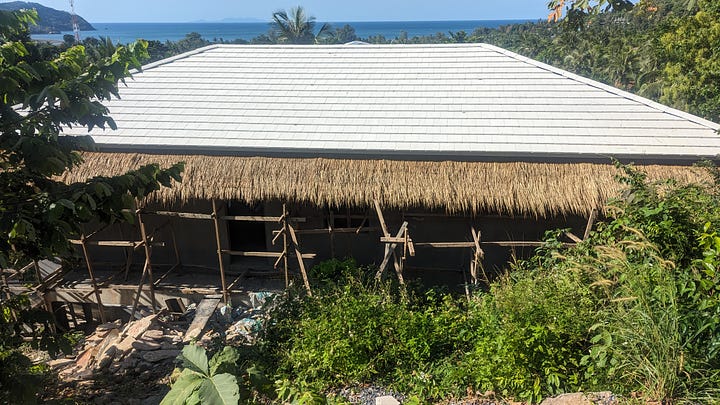
Once I had a layout I liked, I measured everything and flew up to Chiang Mai.
Chiang Mai is Thailand’s holy grail of woodworking and furniture — the place to get custom pieces made for the same price as off-the-rack. I spent a whirlwind week up there with a Thai assistant, scouring everything from tiny family-owned workshops to massive superstores. It was a full-on mission.
One sweltering afternoon, I found myself in a cramped, fluorescent-lit office, designing sofas from scratch with a pair of seasoned craftsmen. But I practically skipped out of there afterward — giddy and proud. I’d conceived what I still think of as the villa’s centrepiece: two sumptuous sculptural sofas and twin armchairs, to be arranged in a deliberate mirror image across the living room — creating both balance and invitation, with a central promenade guiding the gaze toward the open-air terrace and the sweeping view beyond.
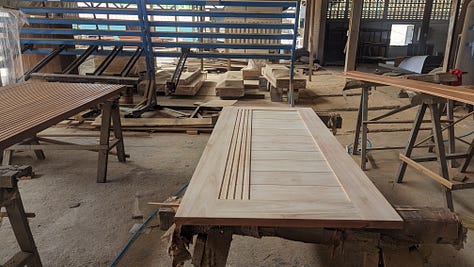
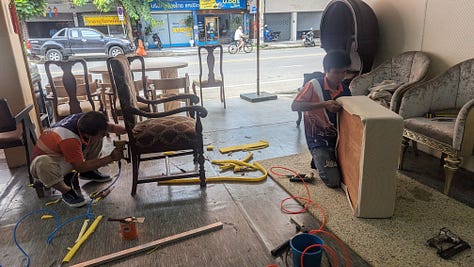

Gruelling as the week was, there was something deeply satisfying about it. Designing each piece by hand. Selecting each finish with intention. Choosing beauty and function with care. For the first time in a long while, I felt like I was in my element again.
I returned to Koh Phangan in mid-June. And even though I’d nailed down most of the furnishings, we were already over budget — thanks to the original contractors, and now, the cost of fixing their mistakes.
We’d always known we couldn’t afford to furnish the villa just yet. The idea had been that Fraser would pull in extra profits from Sand & Stone to cover it. But that quickly changed.
The ripple effects from Covid, combined with the villa boom on the island, meant that building materials were getting harder to source — and much more expensive. Labour costs surged too. There just weren’t enough contractors or subs to go around, so those who were available could name their price.
So suddenly, every spare baht had to go into the build itself.
Running on fumes
As time wore on, so did the list of things that needed fixing, finishing, or just straight-up doing differently. Fraser didn’t get to where he is by letting subpar work slide. And I’ve always had a painfully high bar — for quality, for beauty, for everything.
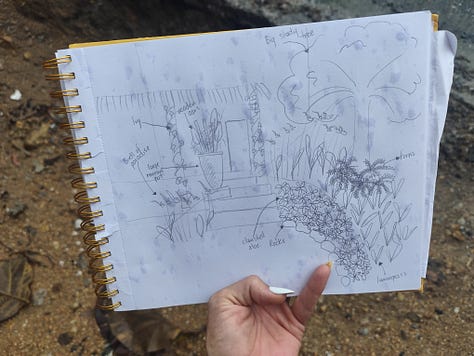
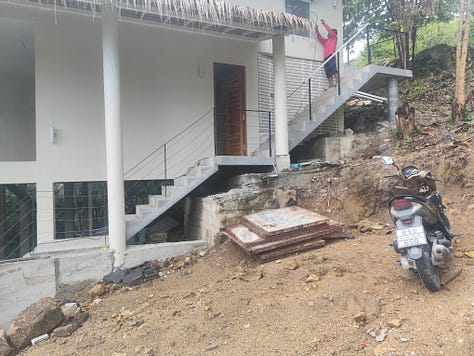
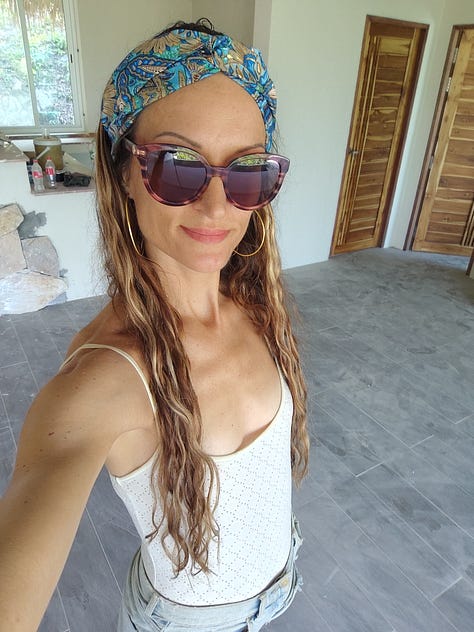

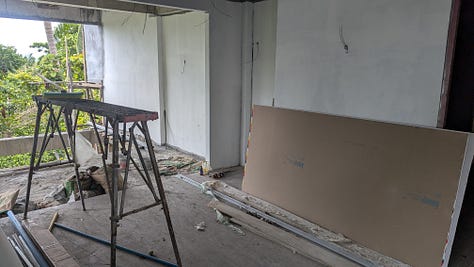

Which is great for whoever ends up buying this villa. But didn't do wonders for our marriage. We've had so many disagreements and fights over this villa, it's a wonder we've made it this far with our wedding rings still on.
By the time autumn hit, it was obvious: Fraser couldn’t be the one to fund the furnishings. Not without burning out or putting the business at risk. Our friends had no more money to put in. Anything more would have to come from our side.
Our real estate agent tried to reassure us. “You can sell it as a shell,” he said. “The standard speaks for itself.”
He was wrong.
We had a few showings. But none of them led anywhere. The villa just wasn’t shifting.
So I turned to the one thing I still had in me: my art.
With nothing but a brush and paint pots (and very little energy), I hand-painted two murals — one by the entrance and another inside. It had been over a decade since I’d painted a mural. It took longer than I expected. But the results? Worth it. They gave the space heart. Soul. A little bit of me.
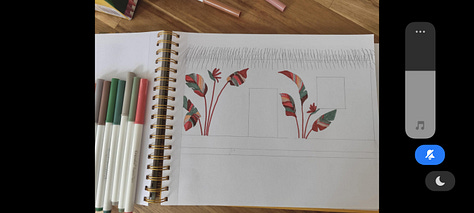

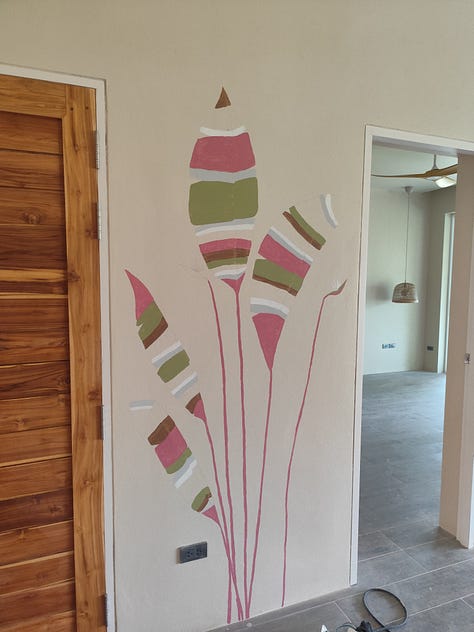
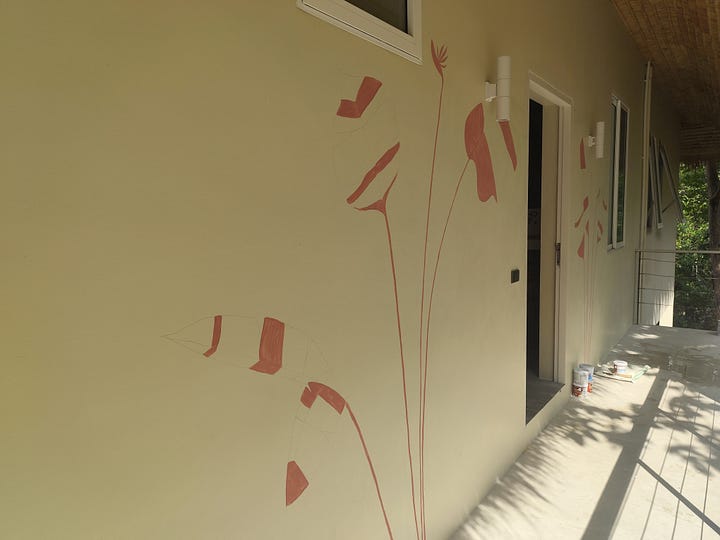

Then, at the end of January, just as I was adding the final touches, my phone rang. A doctor in Mexico. My mom had 72 hours left to live.
It was the final blow in a year already cracked wide open. And this one split the ground right beneath me.
Everything stopped. We flew to Mexico. We said goodbye. We grieved. And we tried — in that dazed, underwater way you do after a seismic loss — to figure out how to begin again.
I didn’t want to return. I couldn’t. Just the thought of being back in the villa made me flinch. That phone call had changed everything. The walls didn’t feel like home anymore — they felt haunted by grief.
I prayed it would sell while we were away.
It didn’t.
And when we finally made it back, the market had shifted, too. With waves of families moving to Koh Phangan from Israel and Russia, the hot-ticket villas were now mid-range, ready-to-go homes. Not luxury shells.
The luxury market was much smaller, and much pickier, now.
“Buyers want turnkey,” our agent told us. “They’re investors. They don’t want to deal with furniture deliveries or design decisions. They just want something they can list.”
Would’ve been useful to know a year earlier. But here we were.
“We’re going to have to furnish it,” Fraser said, somewhere between Mexico and Thailand.
My heart sank.
I had everything planned the year before — colour palettes, lighting schemes, even where the spoons would go. But after Fraser pulled the plug for budget reasons, I let it all go. And now, elbows deep in grief, I was expected to scoop up all those scattered plans, hold them together, and make magic?
I could barely hold myself together. But there was no other choice.
No Money. No Time. No Choice.
If there had been another way, I would have taken it.
But our friends needed their investment back. It had been nearly two years since we’d started the build, and we’d told them — optimistically, earnestly — that we’d likely sell within one. Sure, that’s the nature of investments. But it didn’t stop me from feeling responsible. And we needed the sale too — most of our capital was tied up in the villa.
There was no getting around it. I had to bite the bullet, sit down at my laptop, and start piecing the plan back together from wherever I’d left it last.
Fraser, meanwhile, was also grieving. The poor man had had to deal with not only the loss of my mother and the human puddle I'd become as a result, but also his young cousin, who had passed away at just 31 a couple days before my mom. And still had to return as CEO of our company. We’d taken on a partner by this point — thank god — so things didn’t fall apart entirely while we were away. But his post-Mexico to-do list was brutal. And on top of everything else, he had the Woodrow to manage.
We didn’t have the time. We didn’t have the money.
We also didn’t have a choice.
So we got back to work. Hired new teams. Ordered new supplies. I found my old files, my mood boards, my notes — and started again.
Fraser was forced to agree to a business deal that we know will hurt later, but it bought us what we needed: immediate capital to finish, furnish, and (hopefully) shift this behemoth.
And now? The pieces are finally coming together.

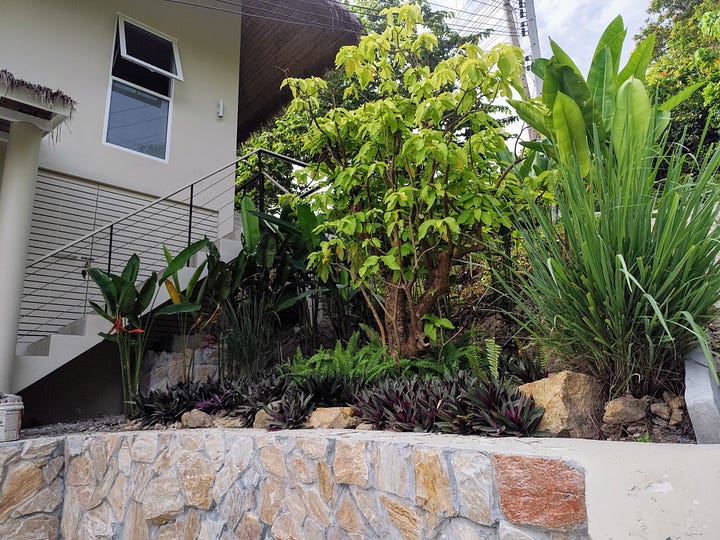
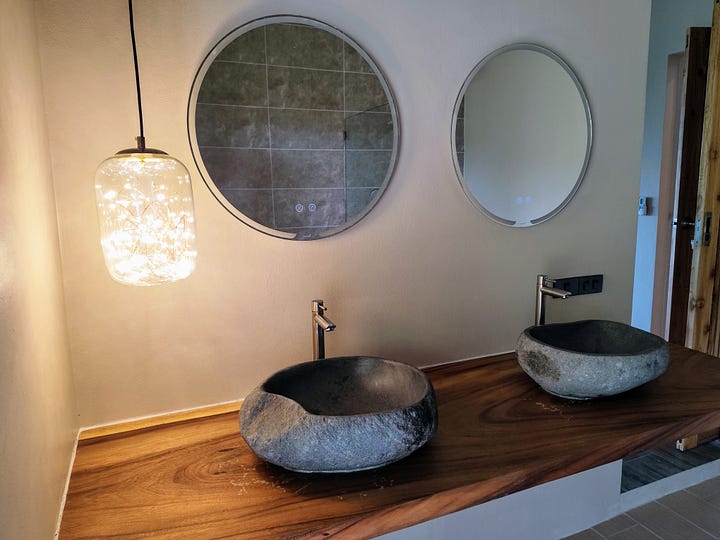
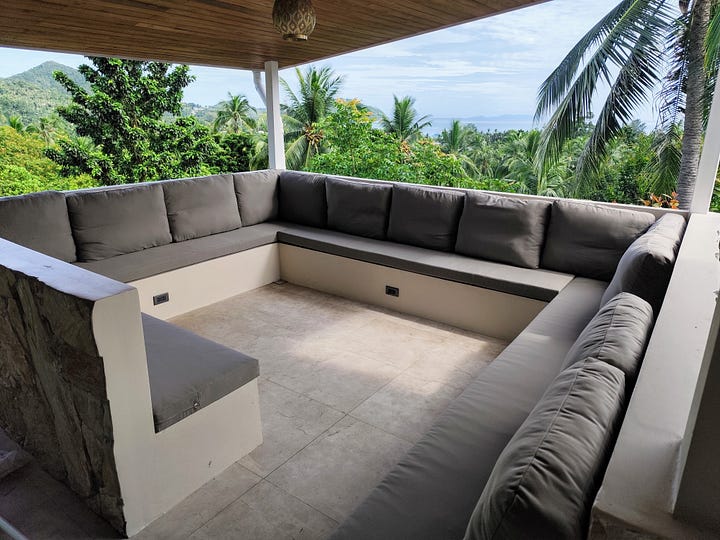
There’s water in the pool. Cushions in the sala. Curtains hanging from the sliding doors. The comfiest mattresses known to humankind in the bedrooms. Our favourite carpenters are coming at the end of the month to install the kitchen, closets, bed frames, and a few other custom pieces Fraser and I designed ourselves.
Sometimes when we go up, we bring Hudson and swim stuff and make an afternoon of it. It’s nice to get some enjoyment out of what we’ve worked so hard on.
This weekend, we’re heading to the mainland to do a big haul at one of those giant building supply complexes. Not exactly our dream Father’s Day plan — but if we ever want this villa to sell, it’s necessary. The list is long, but this shop should cover the rest of the final furnishings.
And now, almost — almost — we’re at the end.
The Woodrow is more than just a villa. It’s the culmination of years of experience, heartbreak, and hard-won lessons. It sits on a rare 1,000-square-metre plot in one of Koh Phangan’s last quiet corners — lush, serene, and still untouched by the chaos devouring the rest of the island. There’s a panoramic seaview, a rain-triggered river running down one side, and a breeze that moves through the trees like it knows something you don’t yet.
Every curve and corner has a story. The layout has been refined over multiple builds. The custom furniture? I literally sweated through designing it in Chiang Mai. And the interiors — even after everything — got every last drop of creativity I had left.
Financially, it’s solid. We’ve run the numbers. Based on the villas we’ve built and sold before this one — and the Airbnb returns we managed ourselves — it’ll bring in 8–10% annually.
But beyond the spreadsheets, this place holds so much of us. A chapter we’re almost ready to close.
Because come August, we’re heading to Spain. To build something new. Not for a client. Not for investors. But for us.
A home. A life.
So here we are. Finishing the last brush strokes. Sweeping up the dust. Letting go.
And hoping that the next person who walks through the door feels what we felt the day we first saw this land:
That deep, unmistakable sense that this is the beginning of something good.
If this story moved you, made you laugh, or made you think twice about building a villa in the tropics — give it a restack, send it to a friend, or hit that little subscribe button. It helps more than you know, and it means I get to keep writing stories like this one.
If you have any questions about the villa building process or generally building homes abroad, comment down below. If you’d like to know more about The Woodrow, send me a DM!






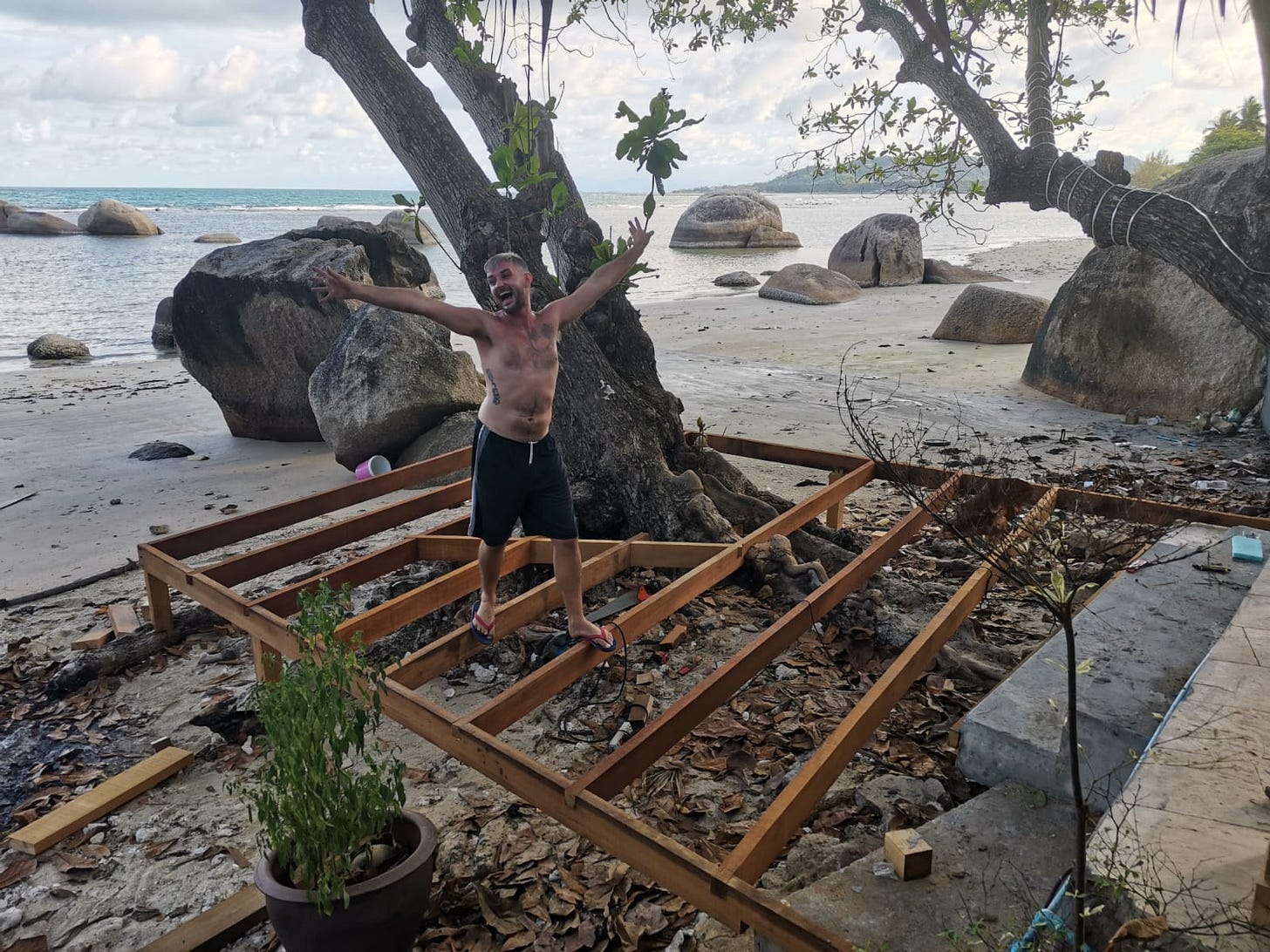
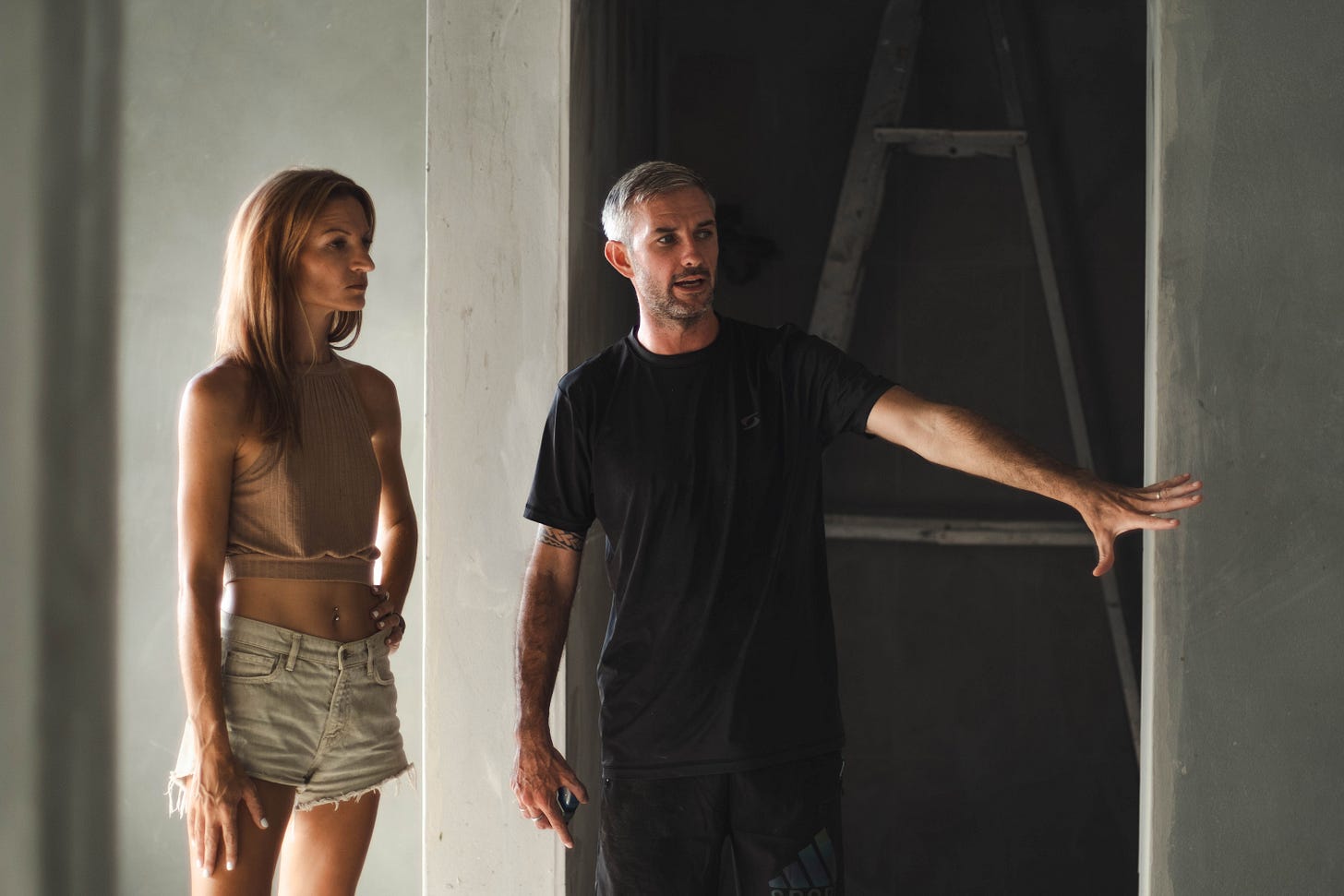
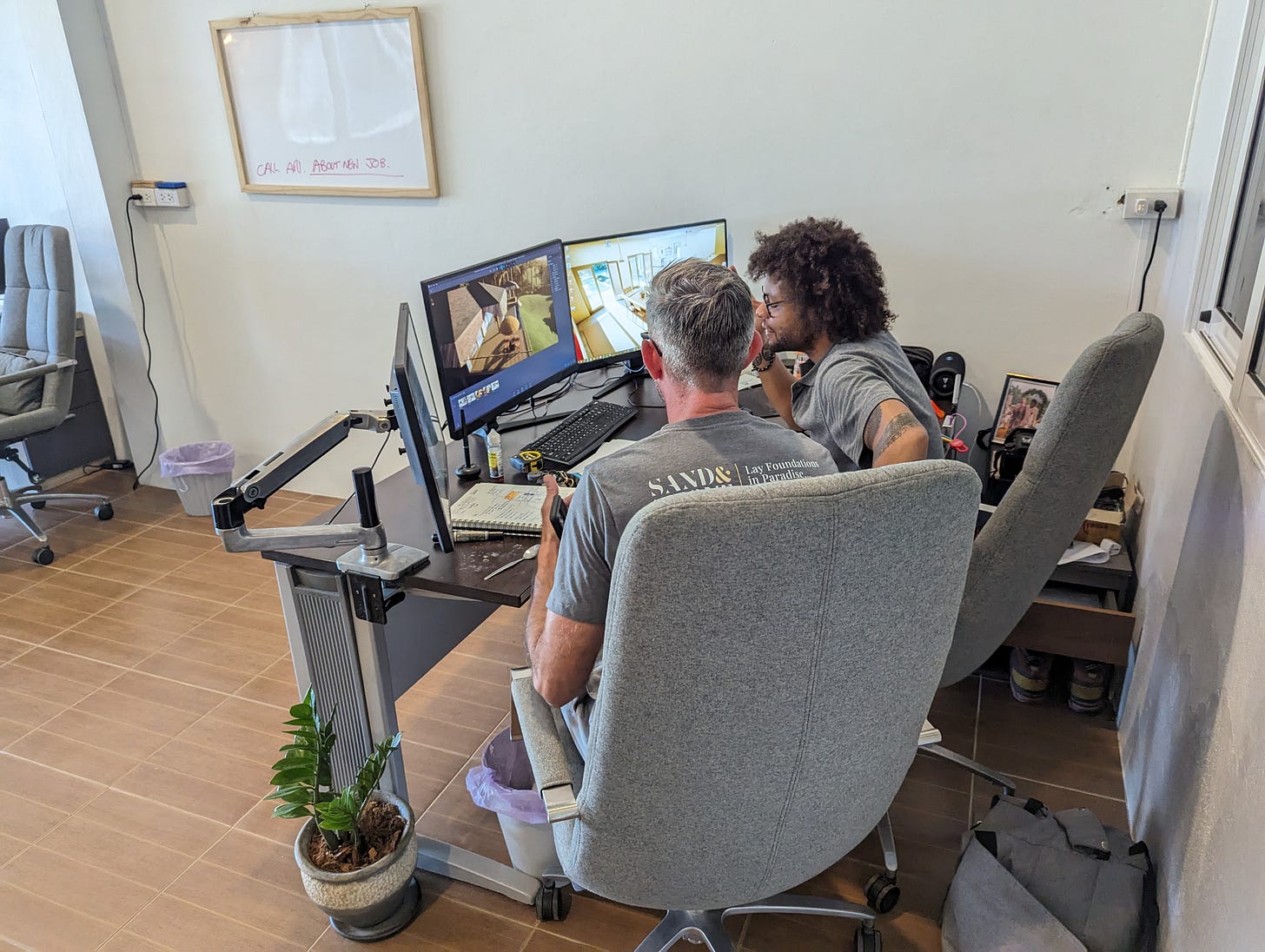
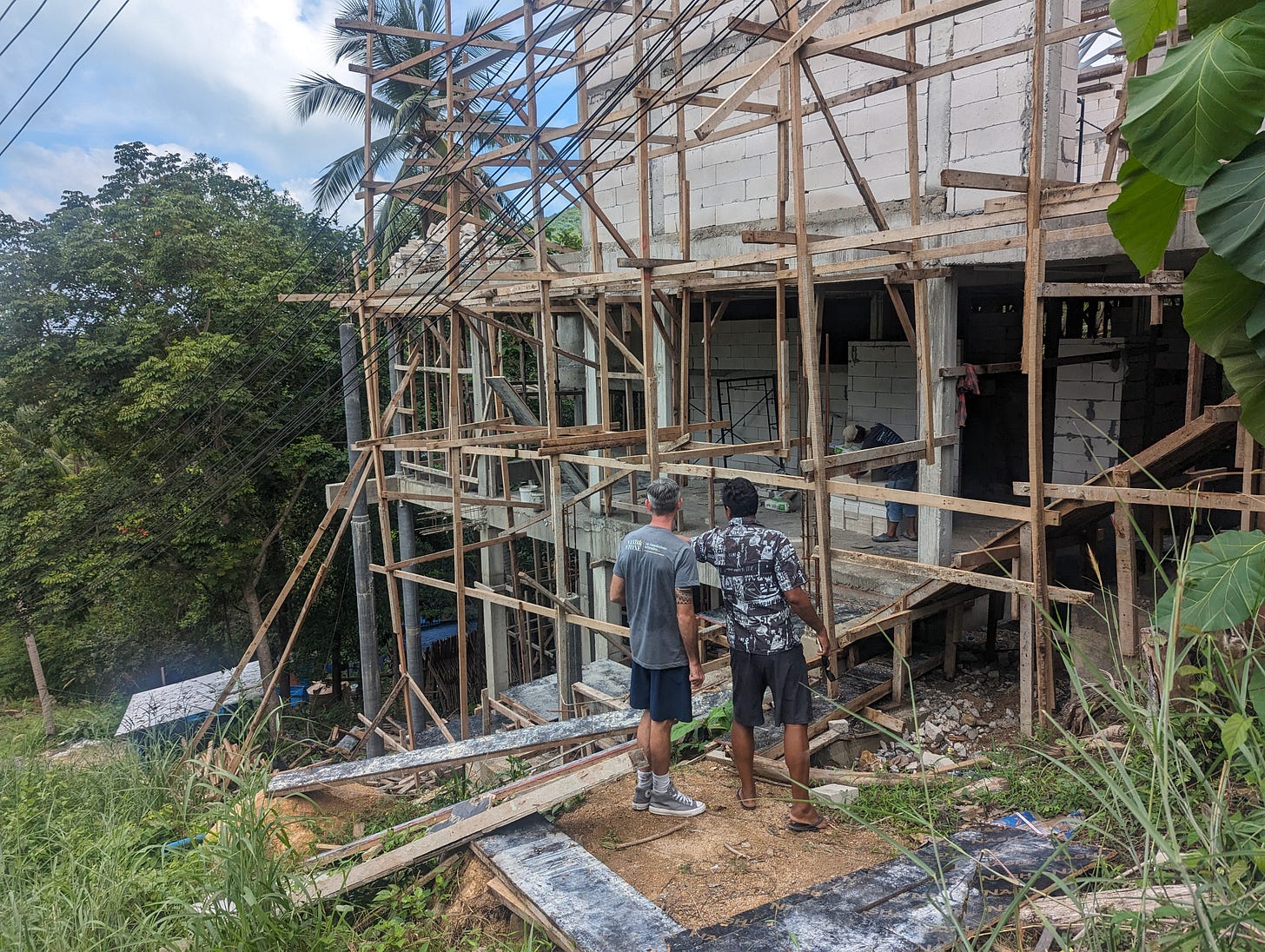
What a great piece. You had me holding my breath till the end! Relieved it all worked out, but man, what a slog.
Thanks for sharing this story. This is so much of hard work and stress. I am happy to hear that it is finally almost at the end. All the best for selling the Villa. You have put so much heart in it!